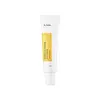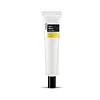What's inside
What's inside
 Key Ingredients
Key Ingredients

 Benefits
Benefits

 Concerns
Concerns

 Ingredients Side-by-side
Ingredients Side-by-side

Water
Skin ConditioningButylene Glycol
HumectantGlycerin
HumectantHippophae Rhamnoides Fruit Extract
Skin ConditioningCaprylic/Capric Triglyceride
MaskingNiacinamide
SmoothingCetyl Ethylhexanoate
EmollientCetearyl Olivate
1,2-Hexanediol
Skin ConditioningSorbitan Olivate
EmulsifyingCetearyl Alcohol
EmollientPolyglyceryl-3 Methylglucose Distearate
EmulsifyingVinyldimethicone
Behenyl Alcohol
EmollientAcrylates/C10-30 Alkyl Acrylate Crosspolymer
Emulsion StabilisingAmmonium Acryloyldimethyltaurate/Vp Copolymer
Caprylyl Glycol
EmollientStearyl Alcohol
EmollientPentylene Glycol
Skin ConditioningCeteth-13
EmulsifyingHydroxyacetophenone
AntioxidantTromethamine
BufferingXanthan Gum
EmulsifyingBetaine
HumectantTrehalose
HumectantAllantoin
Skin ConditioningPropolis Extract
Skin ConditioningAdenosine
Skin ConditioningDisodium EDTA
Camellia Japonica Seed Oil
EmollientPrunus Amygdalus Dulcis Oil
Skin ConditioningOlea Europaea Fruit Oil
MaskingMaltodextrin
AbsorbentCaramel
Cosmetic ColorantHydrogenated Lecithin
EmulsifyingHydroxydecyl Ubiquinone
AntioxidantCitrus Aurantium Bergamia Fruit Oil
MaskingBeta-Glucan
Skin ConditioningCentella Asiatica Extract
CleansingPolygonum Cuspidatum Root Extract
AntioxidantScutellaria Baicalensis Root Extract
AstringentCamellia Sinensis Leaf Extract
AntimicrobialDipotassium Glycyrrhizate
HumectantChamomilla Recutita Flower Extract
MaskingRosmarinus Officinalis Leaf Extract
AntimicrobialPerilla Frutescens Leaf Extract
MaskingAspalathus Linearis Extract
Skin ConditioningCommiphora Myrrha Resin Extract
Skin ConditioningMelaleuca Alternifolia Leaf Extract
PerfumingGlycyrrhiza Glabra Root Extract
BleachingEthylhexylglycerin
Skin ConditioningPropanediol
SolventSodium Hyaluronate Crosspolymer
HumectantHydrolyzed Glycosaminoglycans
HumectantSodium Hyaluronate
HumectantBenzyl Glycol
SolventHydrolyzed Hyaluronic Acid
HumectantHyaluronic Acid
HumectantRaspberry Ketone
MaskingHydroxypropyltrimonium Hyaluronate
Hydrolyzed Sodium Hyaluronate
Skin ConditioningPotassium Hyaluronate
Skin ConditioningSodium Acetylated Hyaluronate
HumectantWater, Butylene Glycol, Glycerin, Hippophae Rhamnoides Fruit Extract, Caprylic/Capric Triglyceride, Niacinamide, Cetyl Ethylhexanoate, Cetearyl Olivate, 1,2-Hexanediol, Sorbitan Olivate, Cetearyl Alcohol, Polyglyceryl-3 Methylglucose Distearate, Vinyldimethicone, Behenyl Alcohol, Acrylates/C10-30 Alkyl Acrylate Crosspolymer, Ammonium Acryloyldimethyltaurate/Vp Copolymer, Caprylyl Glycol, Stearyl Alcohol, Pentylene Glycol, Ceteth-13, Hydroxyacetophenone, Tromethamine, Xanthan Gum, Betaine, Trehalose, Allantoin, Propolis Extract, Adenosine, Disodium EDTA, Camellia Japonica Seed Oil, Prunus Amygdalus Dulcis Oil, Olea Europaea Fruit Oil, Maltodextrin, Caramel, Hydrogenated Lecithin, Hydroxydecyl Ubiquinone, Citrus Aurantium Bergamia Fruit Oil, Beta-Glucan, Centella Asiatica Extract, Polygonum Cuspidatum Root Extract, Scutellaria Baicalensis Root Extract, Camellia Sinensis Leaf Extract, Dipotassium Glycyrrhizate, Chamomilla Recutita Flower Extract, Rosmarinus Officinalis Leaf Extract, Perilla Frutescens Leaf Extract, Aspalathus Linearis Extract, Commiphora Myrrha Resin Extract, Melaleuca Alternifolia Leaf Extract, Glycyrrhiza Glabra Root Extract, Ethylhexylglycerin, Propanediol, Sodium Hyaluronate Crosspolymer, Hydrolyzed Glycosaminoglycans, Sodium Hyaluronate, Benzyl Glycol, Hydrolyzed Hyaluronic Acid, Hyaluronic Acid, Raspberry Ketone, Hydroxypropyltrimonium Hyaluronate, Hydrolyzed Sodium Hyaluronate, Potassium Hyaluronate, Sodium Acetylated Hyaluronate
Water
Skin ConditioningCaprylic/Capric Triglyceride
MaskingButylene Glycol
HumectantParaffinum Liquidum
EmollientGlycerin
HumectantNiacinamide
SmoothingPetrolatum
EmollientStearic Acid
CleansingBetaine
Humectant1,2-Hexanediol
Skin ConditioningGlyceryl Stearate
EmollientPEG-100 Stearate
Polysorbate 80
EmulsifyingCetearyl Alcohol
EmollientBeeswax
Emulsion StabilisingSorbitan Stearate
EmulsifyingSodium Hyaluronate
HumectantDimethicone
EmollientArginine
MaskingTocopheryl Acetate
AntioxidantCarbomer
Emulsion StabilisingMyrciaria Dubia Fruit Extract
Skin ConditioningEuterpe Oleracea Fruit Extract
Psidium Guajava Fruit Extract
AstringentMalpighia Emarginata Fruit Extract
Skin ConditioningAronia Arbutifolia Extract
Skin ConditioningLycium Barbarum Fruit Extract
AstringentGlycyrrhiza Inflata Root Extract
Skin ConditioningHamamelis Virginiana Extract
AntiseborrhoeicPanax Ginseng Root Extract
EmollientVaccinium Angustifolium Fruit Extract
Skin ProtectingPunica Granatum Fruit Extract
AntioxidantGalactomyces Ferment Filtrate
HumectantHydrolyzed Chitosan
Skin ConditioningRetinyl Acetate
Skin ConditioningAscorbic Acid
AntioxidantAllantoin
Skin ConditioningDisodium EDTA
Ethylhexylglycerin
Skin ConditioningParfum
MaskingWater, Caprylic/Capric Triglyceride, Butylene Glycol, Paraffinum Liquidum, Glycerin, Niacinamide, Petrolatum, Stearic Acid, Betaine, 1,2-Hexanediol, Glyceryl Stearate, PEG-100 Stearate, Polysorbate 80, Cetearyl Alcohol, Beeswax, Sorbitan Stearate, Sodium Hyaluronate, Dimethicone, Arginine, Tocopheryl Acetate, Carbomer, Myrciaria Dubia Fruit Extract, Euterpe Oleracea Fruit Extract, Psidium Guajava Fruit Extract, Malpighia Emarginata Fruit Extract, Aronia Arbutifolia Extract, Lycium Barbarum Fruit Extract, Glycyrrhiza Inflata Root Extract, Hamamelis Virginiana Extract, Panax Ginseng Root Extract, Vaccinium Angustifolium Fruit Extract, Punica Granatum Fruit Extract, Galactomyces Ferment Filtrate, Hydrolyzed Chitosan, Retinyl Acetate, Ascorbic Acid, Allantoin, Disodium EDTA, Ethylhexylglycerin, Parfum
 Reviews
Reviews

Ingredients Explained
These ingredients are found in both products.
Ingredients higher up in an ingredient list are typically present in a larger amount.
1,2-Hexanediol is a synthetic liquid and another multi-functional powerhouse.
It is a:
- Humectant, drawing moisture into the skin
- Emollient, helping to soften skin
- Solvent, dispersing and stabilizing formulas
- Preservative booster, enhancing the antimicrobial activity of other preservatives
Allantoin is a soothing ingredient known for its protective and moisturizingg properties. Because of this, it is often added to products with strong active ingredients.
Studies show higher concentrations of this ingredient can promote wound healing.
Though it can be derived from the comfrey plant, allantoin is produced synthetically for cosmetic products to ensure purity.
Learn more about AllantoinBetaine is a common humectant (a substance that promotes retention of moisture). It's known to be gentle on the skin and can help balance hydration.
This ingredient is best for improving hydration and soothing irritated skin. Studies also show it helps even out skin tone.
Fun fact: Betaine is naturally created in the skin and body. The kind found within cosmetic products can be either plant-derived or synthetic.
Another name for betaine is trimethylglycine.
Learn more about BetaineButylene Glycol (or BG) is used within cosmetic products for a few different reasons:
Overall, Butylene Glycol is a safe and well-rounded ingredient that works well with other ingredients.
Though this ingredient works well with most skin types, some people with sensitive skin may experience a reaction such as allergic rashes, closed comedones, or itchiness.
Learn more about Butylene GlycolThis ingredient is an emollient, solvent, and texture enhancer. It is considered a skin-softener by helping the skin prevent moisture loss.
It helps thicken a product's formula and makes it easier to spread by dissolving clumping compounds.
Caprylic Triglyceride is made by combining glycerin with coconut oil, forming a clear liquid.
While there is an assumption Caprylic Triglyceride can clog pores due to it being derived from coconut oil, there is no research supporting this.
Learn more about Caprylic/Capric TriglycerideCetearyl alcohol is a mixture of two fatty alcohols: cetyl alcohol and stearyl alcohol. It is mainly used as an emulsifier. Emulsifiers help prevent the separation of oils and products. Due to its composition, it can also be used to thicken a product or help create foam.
Cetearyl alcohol is an emollient. Emollients help soothe and hydrate the skin by trapping moisture.
Studies show Cetearyl alcohol is non-toxic and non-irritating. The FDA allows products labeled "alcohol-free" to have fatty alcohols.
This ingredient is usually derived from plant oils such as palm, vegetable, or coconut oils. There is debate on whether this ingredient will cause acne.
Due to the fatty acid base, this ingredient may not be Malassezia folliculitis safe.
Learn more about Cetearyl AlcoholDisodium EDTA plays a role in making products more stable by aiding other preservatives.
It is a chelating agent, meaning it neutralizes metal ions that may be found in a product.
Disodium EDTA is a salt of edetic acid and is found to be safe in cosmetic ingredients.
Learn more about Disodium EDTAEthylhexylglycerin (we can't pronounce this either) is commonly used as a preservative and skin softener. It is derived from glyceryl.
You might see Ethylhexylglycerin often paired with other preservatives such as phenoxyethanol. Ethylhexylglycerin has been found to increase the effectiveness of these other preservatives.
Glycerin is already naturally found in your skin. It helps moisturize and protect your skin.
A study from 2016 found glycerin to be more effective as a humectant than AHAs and hyaluronic acid.
As a humectant, it helps the skin stay hydrated by pulling moisture to your skin. The low molecular weight of glycerin allows it to pull moisture into the deeper layers of your skin.
Hydrated skin improves your skin barrier; Your skin barrier helps protect against irritants and bacteria.
Glycerin has also been found to have antimicrobial and antiviral properties. Due to these properties, glycerin is often used in wound and burn treatments.
In cosmetics, glycerin is usually derived from plants such as soybean or palm. However, it can also be sourced from animals, such as tallow or animal fat.
This ingredient is organic, colorless, odorless, and non-toxic.
Glycerin is the name for this ingredient in American English. British English uses Glycerol/Glycerine.
Learn more about GlycerinNiacinamide is a multitasking form of vitamin B3 that strengthens the skin barrier, reduces pores and dark spots, regulates oil, and improves signs of aging.
And the best part? It's gentle and well-tolerated by most skin types, including sensitive and reactive skin.
You might have heard of "niacin flush", or the reddening of skin that causes itchiness. Niacinamide has not been found to cause this.
In very rare cases, some individuals may not be able to tolerate niacinamide at all or experience an allergic reaction to it.
If you are experiencing flaking, irritation, and dryness with this ingredient, be sure to double check all your products as this ingredient can be found in all categories of skincare.
When incorporating niacinamide into your routine, look out for concentration amounts. Typically, 5% niacinamide provides benefits such as fading dark spots. However, if you have sensitive skin, it is better to begin with a smaller concentration.
When you apply niacinamide to your skin, your body converts it into nicotinamide adenine dinucleotide (NAD). NAD is an essential coenzyme that is already found in your cells as "fuel" and powers countless biological processes.
In your skin, NAD helps repair cell damage, produce new healthy cells, support collagen production, strengthen the skin barrier, and fight environmental stressors (like UV and pollution).
Our natural NAD levels start to decline with age, leading to slower skin repair, visible aging, and a weaker skin barrier. By providing your skin niacinamide, you're recharging your skin's NAD levels. This leads to stronger, healthier, and younger looking skin.
Another name for vitamin B3 is nicotinamide. This vitamin is water-soluble and our bodies don't store it. We obtain Vitamin B3 from either food or skincare. Meat, fish, wheat, yeast, and leafy greens contain vitamin B3.
The type of niacinamide used in skincare is synthetically created.
Learn more about NiacinamideSodium Hyaluronate is hyaluronic acid's salt form. It is commonly derived from the sodium salt of hyaluronic acid.
Like hyaluronic acid, it is great at holding water and acts as a humectant. This makes it a great skin hydrating ingredient.
Sodium Hyaluronate is naturally occurring in our bodies and is mostly found in eye fluid and joints.
These are some other common types of Hyaluronic Acid:
Learn more about Sodium HyaluronateWater. It's the most common cosmetic ingredient of all. You'll usually see it at the top of ingredient lists, meaning that it makes up the largest part of the product.
So why is it so popular? Water most often acts as a solvent - this means that it helps dissolve other ingredients into the formulation.
You'll also recognize water as that liquid we all need to stay alive. If you see this, drink a glass of water. Stay hydrated!
Learn more about Water